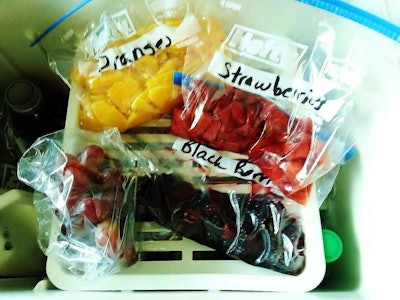 Overdrive George and Wendy Show blogger Wendy Parker rides frequently with her owner-operator husband, George. This picture shows a few of the baggies of cut fruits and veggies she commonly prepares for the truck’s cooler before the pair sets off.
Overdrive George and Wendy Show blogger Wendy Parker rides frequently with her owner-operator husband, George. This picture shows a few of the baggies of cut fruits and veggies she commonly prepares for the truck’s cooler before the pair sets off.I’m always looking for ways to feed my family in a healthier way. We all know the obstacles in trying to eat healthy on the road — it’s challenging to find fresh fruits and vegetables out here. Some of the choices I’ve seen at truck stops looks like they came from the bowl of plastic fruit on my Granny’s kitchen table. I find it difficult to enjoy eating oranges that don’t smell like oranges when they’re cut open, or apples that are so waxy they stick to your lips.
We travel with our own supply of fruits and vegetables, and in the past few years I’ve begun buying more and more of the organically grown variety. One of the biggest reasons for my choice is taste. In my opinion, organic produce has a better flavor. It also lacks preservatives, so the supply is fresher than non-organic due to the shortened amount of time before it goes bad. It’s definitely not as pretty as conventionally grown, and we have to eat it quicker, but in most cases the flavor makes it worth the drawbacks.
If you’re considering making the switch to organics, here’s some information to help you shop for the best bang for your buck. At the grocery, organic food costs anywhere from 20 to 100 percent more; knowing a few things about it before you buy it can help you stretch the dollar. Just because something claims to be organic doesn’t mean it is.
 Unless you’re growing it yourself in a backyard garden, organic produce can be pricey — or not, depending on what’s in season in your area and other factors.
Unless you’re growing it yourself in a backyard garden, organic produce can be pricey — or not, depending on what’s in season in your area and other factors.There’s nothing new about organic foods — organic farming has always been around. What are considered “conventional” methods now began to become widespread more than 50 years ago, after intensive techniques were introduced to feed the wartime population. Some farmers rejected the reasoning behind artificial chemicals, and continued with the old methods, which we now call “organic.”
The term itself, for marketing purposes, comes with specific guidelines defined by the United States Department of Agriculture (USDA) National Organic Program. The Organic Food Production Act of 1990 required that the USDA develop national standards for organic products. The NOP Final Rule was first published in the Federal Register in 2000.
It states that organic meat, poultry, eggs and dairy products come from animals that are given no antibiotics or growth hormones. Organic plant foods are produced without using most conventional pesticides, fertilizers made with synthetic ingredients or sewage sludge, bioengineering or ionizing radiation. A government-approved certifier must inspect the farm to ensure these standards are met. In addition to organic farming, there are USDA standards for organic handling and processing.
There are three levels of organic claims on food labels:
- 100-percent Organic: Products that are completely organic or made of only organic ingredients qualify for this claim and a USDA Organic seal.
- Organic: Products in which at least 95 percent of ingredients are organic qualify for this claim and a USDA Organic seal.
- Made with Organic Ingredients: These are food products in which at least 70 percent of ingredients are certified organic. The USDA organic seal cannot be used but “made with organic ingredients” may appear on its packaging.
There was a time when organics claimed to have more overall nutritional value, however the Annals of Internal Medicine summary concluded that organic foods have no substantial vitamin or mineral advantage (save phosphorous, which is in high abundance in human diets anyway) over foods that are conventionally grown. The study concluded: “The published literature lacks strong evidence that organic foods are significantly more nutritious than conventional foods. Consumption of organic foods may reduce exposure to pesticide residues and antibiotic-resistant bacteria.”
Lack of pesticides and antibiotics, not better nutrition, are the most commonly cited reasons for buying organic over conventional foods. Pesticides are designed to kill things, and have been shown repeatedly to be dangerous for farm workers and other wildlife. They also accumulate up to 30 percent more in the bodies of people who eat conventional produce compared to those who eat organic, and susceptible populations such as children, pregnant and nursing women, and the elderly are at particular risk. It’s also worth noting that organic doesn’t equal “pesticide-free.” Rather, pesticide use is restricted or limited to an allowed list in organic growing.
As a nurse, I can attest to the fact that there are more and more antibiotic-resistant bacteria out there today, and they’re largely blamed on antibiotic feed additives used in large-scale livestock production. Nothing is scarier than a bacteria we can’t kill because it’s stronger than the antibiotics we have.
One of the goals of organically grown and produced foods is to encourage environmentally friendly farming and growth practices, cycling of natural resources, and growing food without the need for harsh pesticides or chemical fertilizers. This makes many organic crops more volatile, but focuses on environmental sustainability as well as yield.
Organics are much more prevalent and easier to find than they used to be. It’s not just for the hippie co-op anymore. Kroger has recently unveiled 68 new organic products, which are distinctly labeled and somewhat on par with nonorganic costs. Walmart is also making an effort to give an organic selection.
The Organic Trade Association says that while organic foods comprised less than 3 percent of total food sales in 2006, annual percentage sales growth in the past decade has been in the high teens into the twenties, up to $16.7 billion.
“Organics is probably the hottest thing going in the food market right now,” said Ted Taft, managing director of Meridian Consulting Group. “The conventional grocery channel has seen that growth and seen that as something they need to have.”









